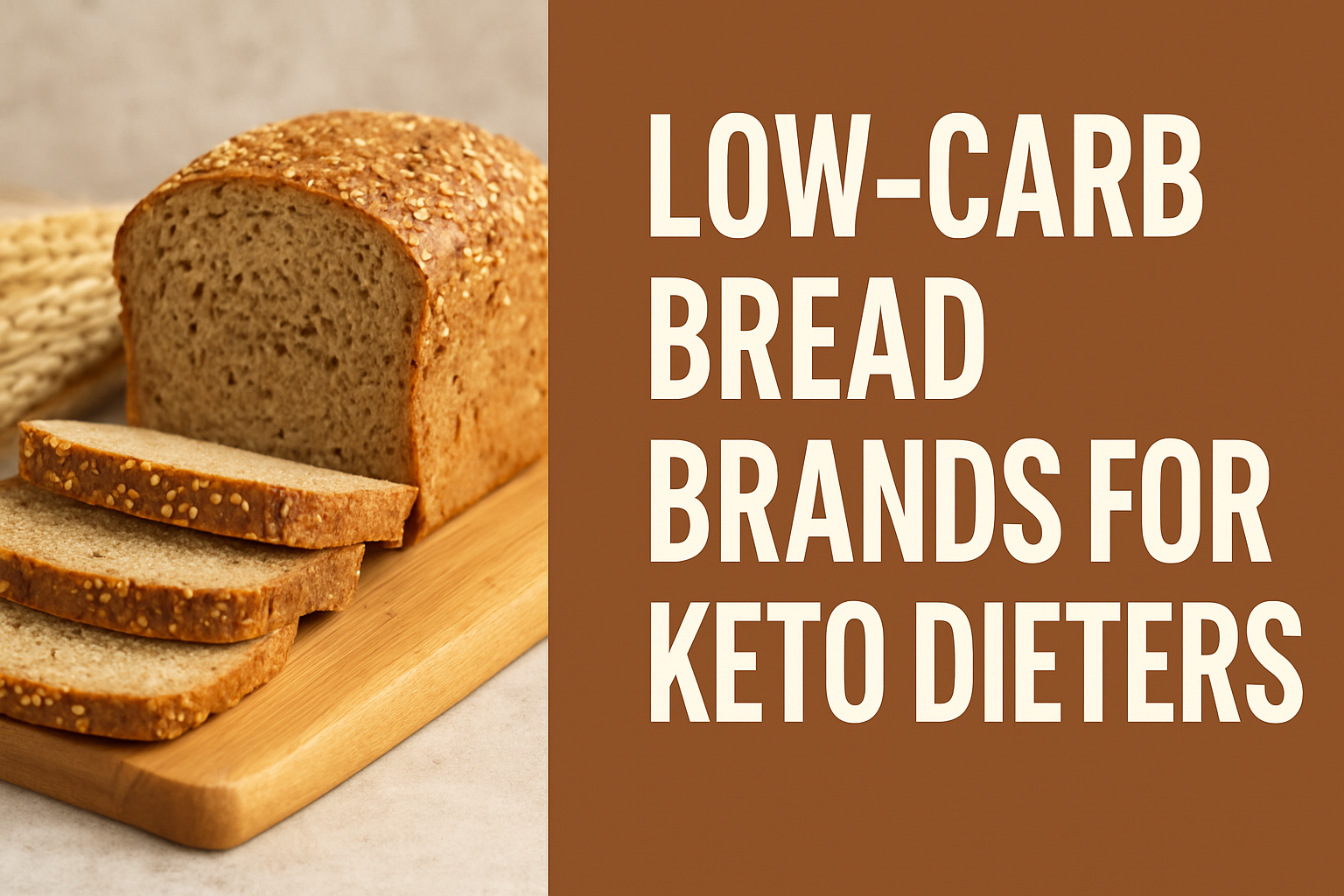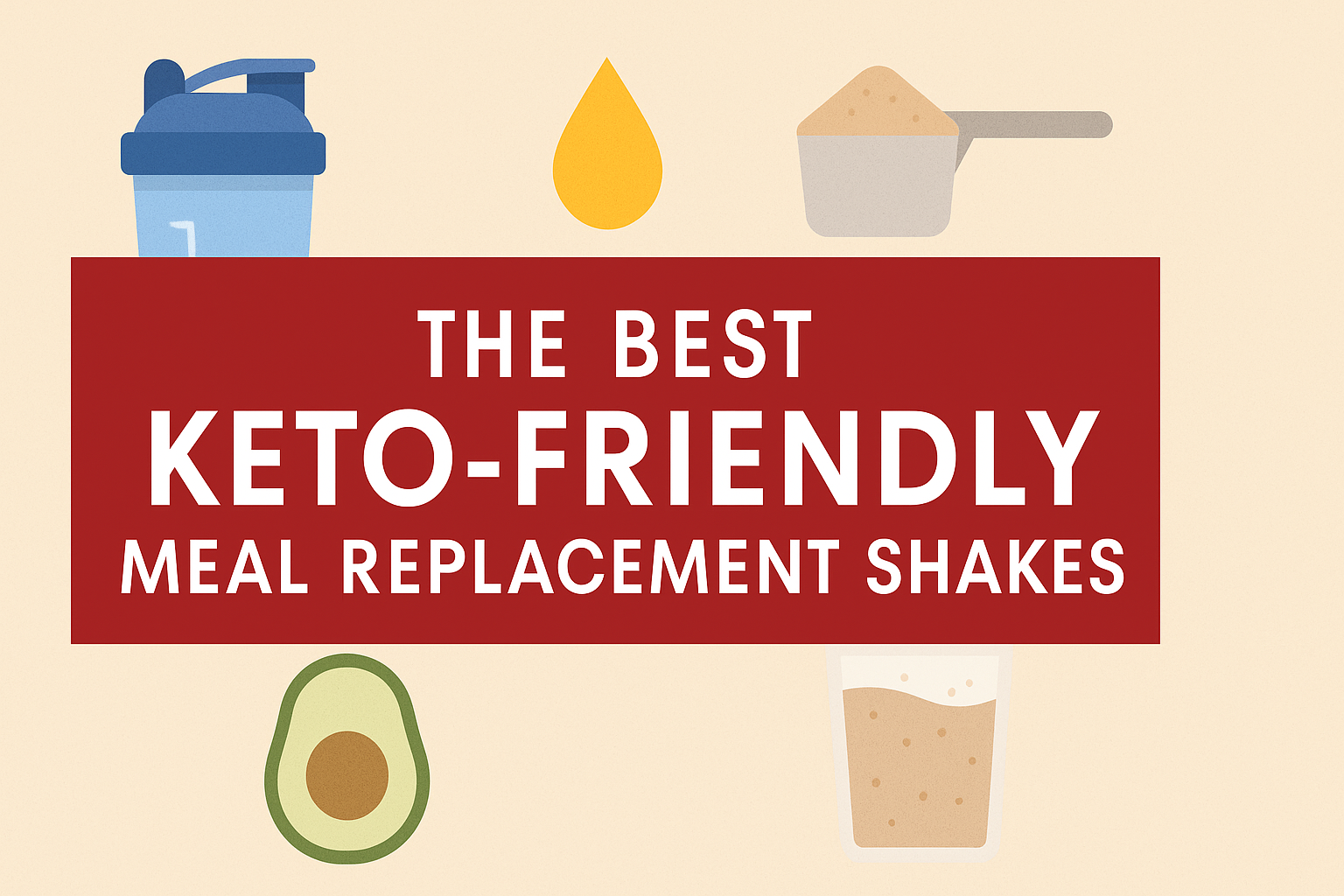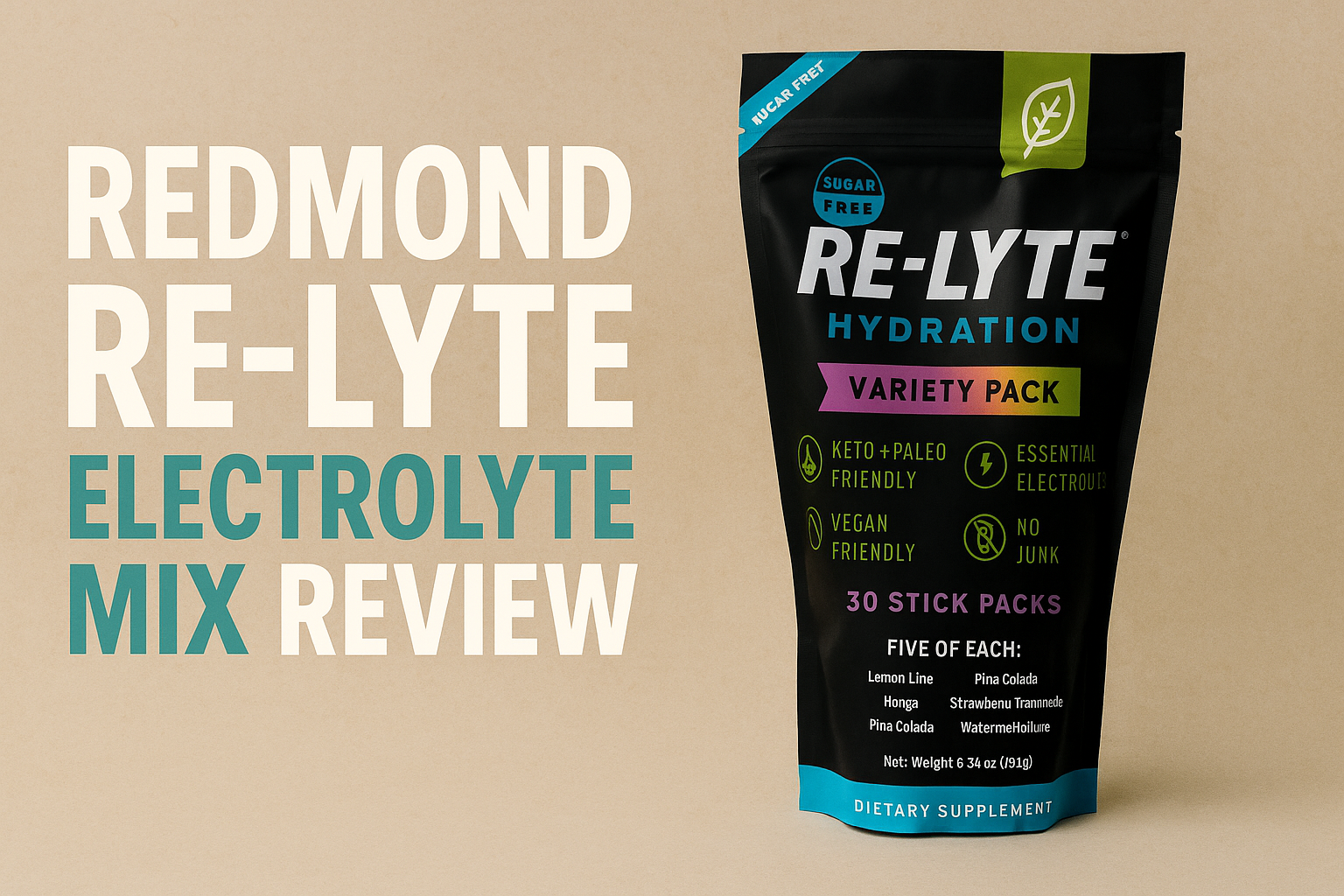When I started my keto journey, one of the hardest things to give up was bread. Suddenly, I felt unable to enjoy the warm, comforting slice with my morning eggs or the quick sandwich on a busy afternoon. But as I dug deeper and tried to make this lifestyle sustainable, I discovered something game-changing: there are actually quite a few low-carb bread brands for keto dieters that don’t taste like cardboard or break the carb bank.
In fact, finding the right bread alternatives made it easier to stick to my goals without feeling deprived. Whether you’re new to keto or looking to add more variety to your low-carb routine, this guide is for you. I’ve explored dozens of options—some surprisingly tasty, others not worth the hype—and put together a list of breads that deliver on texture, flavor, and most importantly, macros.
Let’s break down the top low-carb bread brands for keto dieters, what makes them stand out, and how to choose the right one for your lifestyle.
>>> Check one of my favorite low-carb bread brand HERE <<<
Affiliate Disclaimer: This article contains affiliate links, meaning I may earn a commission if you click and make a purchase at no additional cost to you. As an affiliate, I only recommend products or services I believe will add value to my readers. Your support helps keep this site running. Thank you!
Understanding Keto-Friendly Bread

Ketogenic diets typically limit carbohydrate intake to 20-50 grams per day. This restriction makes
traditional bread off-limits for most keto dieters.
Low-carb bread brands have emerged to fill this gap, using alternative ingredients to create products with minimal net carbs.
The Science Behind Low-Carb Breads
Most keto-friendly breads rely on high-fiber, low-carb ingredients such as:
- Almond flour
- Coconut flour
- Psyllium husk
- Flaxseed meal
These ingredients provide structure and texture while keeping net carb counts low. The concept of ‘net carbs’ is crucial for keto dieters.
It’s calculated by subtracting fiber and sugar alcohols from total carbohydrates.
Practical Applications
Low-carb breads can be used just like regular bread in various ways:
- Making sandwiches
- Toasting for breakfast
- Serving as a side to keto-friendly meals
These alternatives allow dieters to enjoy familiar foods while maintaining ketosis.
Potential Challenges
The main hurdles with keto-friendly breads are texture and taste. Many early attempts at low-carb bread resulted in dense, dry products that barely resembled traditional bread.
However, recent innovations have significantly improved both taste and texture.
Navigating the Low-Carb Bread Market
With the explosion of keto-friendly products, it’s essential to know what to look for when choosing a low-carb bread.
Key Factors to Consider
Net Carb Content
Look for breads with 5 grams of net carbs or less per serving. This ensures that the bread fits within your daily carb allowance without compromising ketosis.
Ingredient Quality
Opt for brands using whole food ingredients rather than artificial additives. High-quality ingredients provide better nutrition but often result in a more satisfying bread experience.
Fiber Content
Higher fiber content can aid digestion and promote feelings of fullness. Many low-carb breads boast impressive fiber counts, which can be useful for overall health.
Protein Content
Many keto breads offer increased protein compared to traditional options. This can help support muscle maintenance and satiety on a ketogenic diet.
Taste and Texture
Some brands more closely mimic traditional bread than others. Personal preference plays a significant role here, so you may need to try a few options to find your favorite.
Popular Low-Carb Bread Brands
Sola Bread

Sola offers a variety of flavors with 2-4 net carbs per slice. Their bread has a texture similar to traditional wheat bread and toasts well.
Check the price and flavors of Sola Bread on Amazon now!
Base Culture
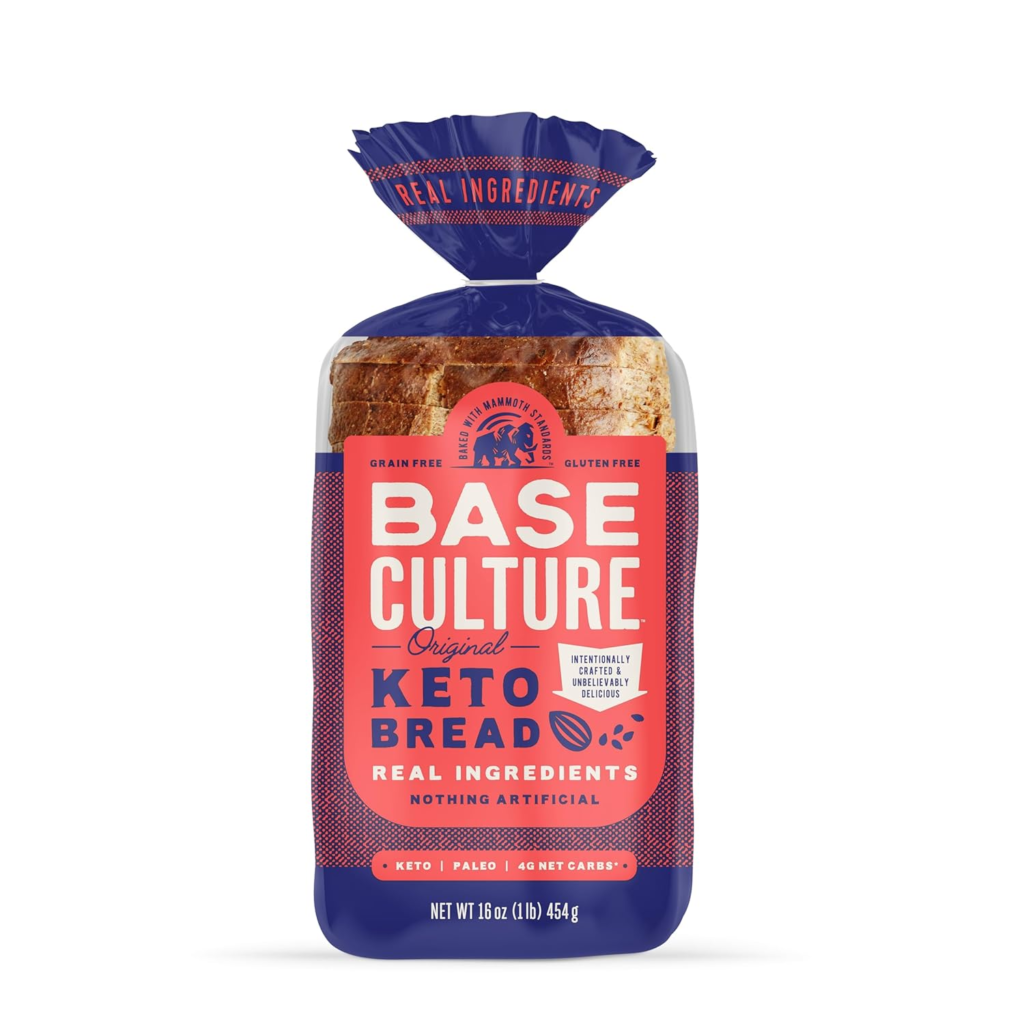
Known for their almond flour-based sandwich bread, Base Culture produces a dense, flavorful option that holds up well in sandwiches.
Check the price and flavors of Base Culture Breads on Amazon now!
Unbun Foods
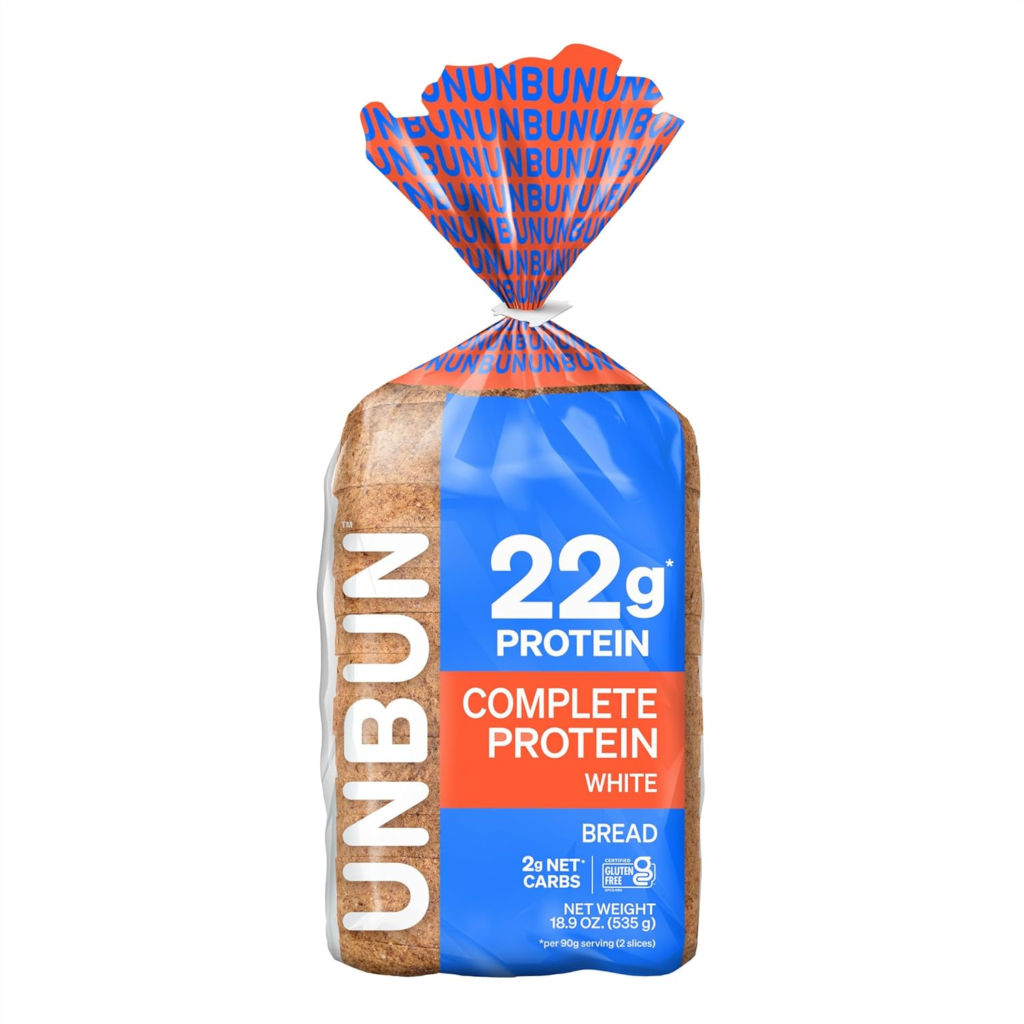
Unbun Foods produces keto-friendly buns and sliced bread using almond and coconut flours. Their products have a slightly sweet taste and work well for burgers and sandwiches.
Check the price of Unbun Bread on Amazon now!
ThinSlim Foods
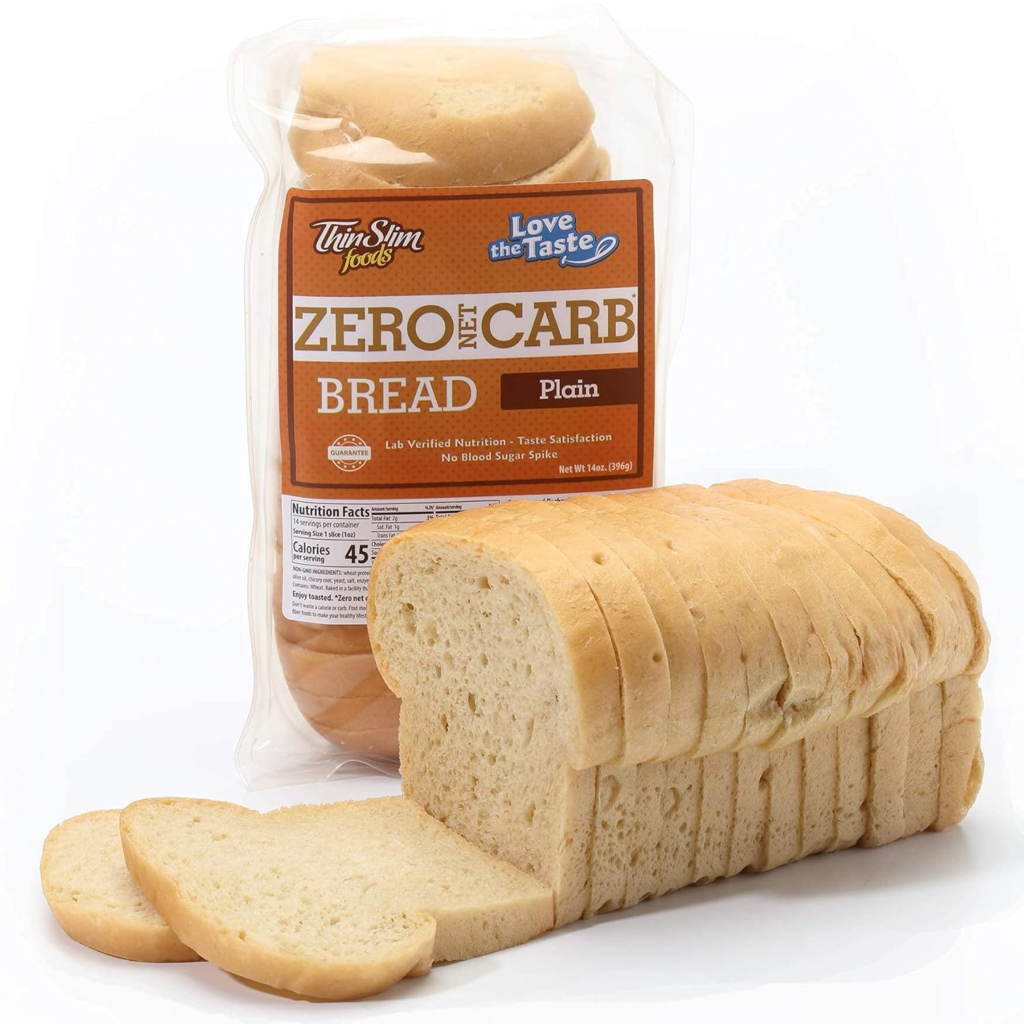
ThinSlim Foods offers a range of low-carb bread products, including bagels and hamburger buns. Their Love-the-Taste bread line is particularly popular among keto dieters.
Check the price of ThinSlim Foods breads and buns on Amazon now!
Hero Bread™ Classic White Bread
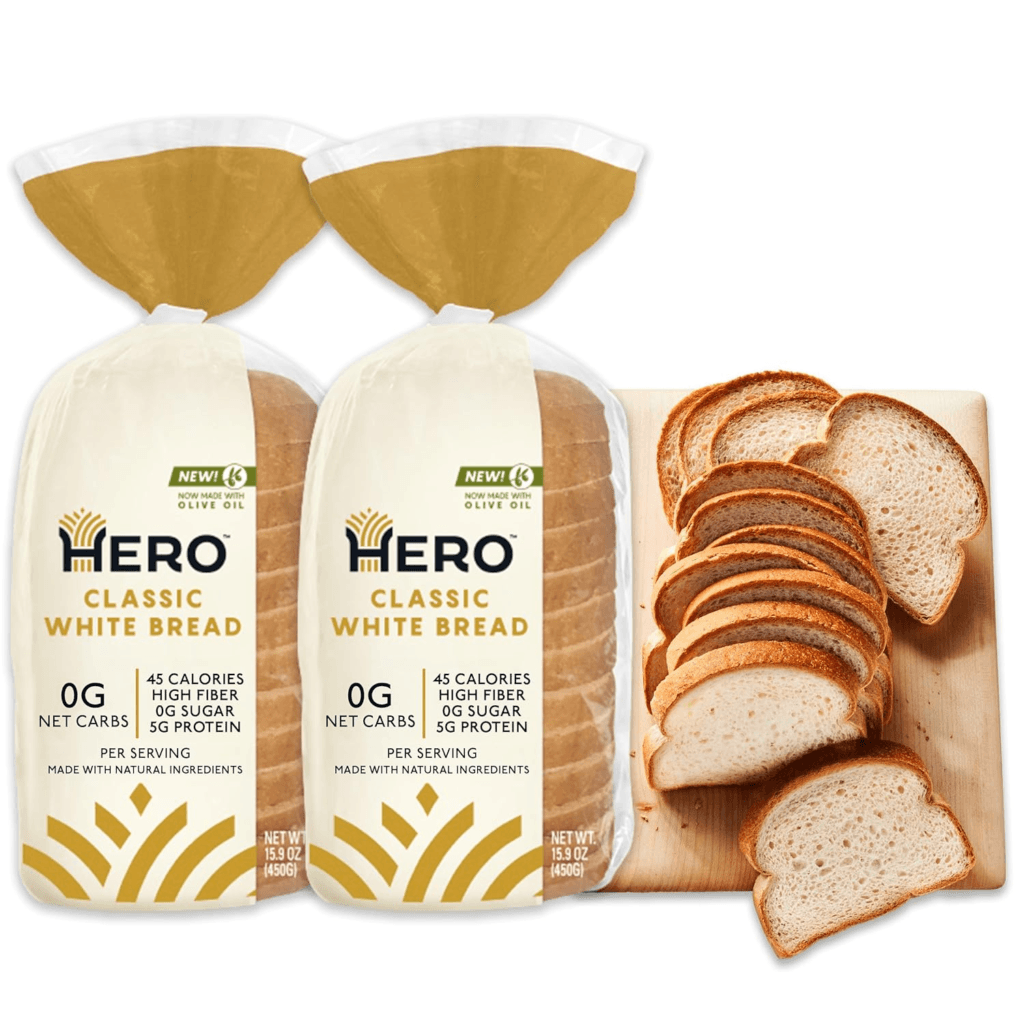
Hero Bread™ Classic White Bread is a delicious, real bread with keto-friendly benefits. Each slice contains 0g net carbs, 0g sugar, and only 45 calories, making it an excellent option for those looking to enjoy bread without the carbs. Made with heart-healthy olive oil, Hero Bread™ packs 5g of protein and 11g of dietary fiber per slice, helping you stay full while supporting digestive health.
Kiss My Keto
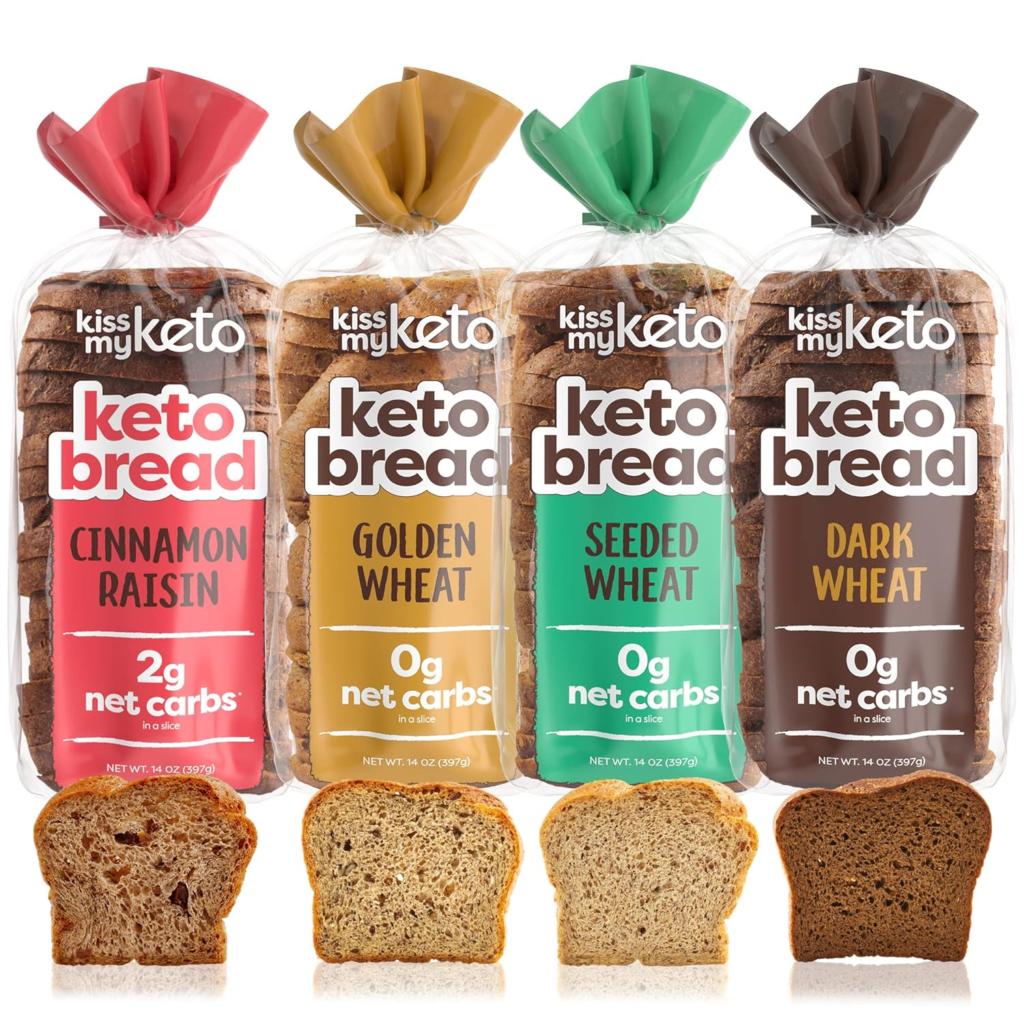
Kiss My Keto provides zero net carb bread made from wheat and oat fiber. Their bread has a light, airy texture that closely resembles traditional white bread.
Check the price of Kiss my Keto Bread on Amazon now!
Incorporating Low-Carb Bread into Your Keto Diet
While low-carb breads can be a valuable addition to a ketogenic diet, it’s important to use them wisely.
Best Practices
Start Slowly
Introduce low-carb bread gradually to assess how your body responds. Some people may experience digestive discomfort when first trying these products because of their high fiber content.
Monitor Ketosis
Use ketone testing strips to ensure these products don’t kick you out of ketosis. While rare, some people may be more sensitive to certain ingredients in low-carb breads.
Practice Portion Control
Even low-carb options should be consumed in moderation. Treat these breads as a supplement to your diet, not a staple.
Pair with Healthy Fats
Enhance satiety by combining your low-carb bread with avocado, nut butter, or cheese. This helps maintain the high-fat ratio required for a ketogenic diet.
Common Pitfalls to Avoid
Overconsumption
The ‘keto-friendly’ label doesn’t mean unlimited consumption. Stick to recommended serving sizes to maintain your macronutrient balance.
Ignoring Other Macros
Remember to balance your overall macronutrient intake. Low-carb bread should fit into your daily macro goals, not replace other essential nutrients.
Neglecting Whole Foods
Low-carb bread shouldn’t replace nutrient-dense whole foods in your diet. Continue to prioritize vegetables, healthy fats, and quality proteins.
Adapting Low-Carb Bread to Different Scenarios
Low-carb breads can be versatile in various dietary situations.
For Athletes
Athletes on a keto diet can use low-carb bread to increase calorie intake without compromising ketosis. Try adding extra protein and healthy fats to your sandwiches for post-workout recovery.
For example, a turkey and avocado sandwich on low-carb bread can provide a good balance of protein and fats.
For Social Situations
Having low-carb bread options can make dining out or attending social gatherings easier. Consider bringing your own low-carb buns to barbecues or requesting lettuce wraps at restaurants.
This allows you to join in social eating without compromising your diet.
For Meal Prep
Many low-carb breads freeze well, making them ideal for meal prep. Prepare sandwiches in advance for quick, keto-friendly lunches throughout the week.
You can also pre-slice and freeze bread to extend its shelf life and have it ready for toasting.
Advancing Your Keto Bread Knowledge
As you become more comfortable with low-carb bread options, consider exploring homemade recipes. Making your own keto bread allows for complete control over ingredients and can be more cost-effective in the long run.
Experimenting with Ingredients
Try incorporating different low-carb flours like sunflower seed flour or lupin flour for unique flavors and textures. Experiment with adding herbs, seeds, or spices to create your perfect keto bread.
For example, adding rosemary and sea salt to an almond flour-based bread can create a delicious savory option.
Practice Makes Perfect
To truly master the art of incorporating low-carb bread into your keto lifestyle, try these exercises:
Bread Tasting
Sample different brands and varieties to find your favorites. Keep notes on taste, texture, and how well each option fits into your diet.
Recipe Testing
Try making your own low-carb bread at home. Start with simple recipes and gradually experiment with more complex ones as you gain confidence.
Meal Planning
Create a week’s worth of meals incorporating low-carb bread options. This helps ensure variety and prevents overreliance on any single product.
Macronutrient Tracking
Keep a detailed food diary to ensure your low-carb bread fits within your keto macros. This practice helps you maintain balance in your overall diet.
The Role of Fiber in Low-Carb Breads
Fiber plays a crucial role in many low-carb bread formulations. It helps reduce net carb count and provides several health benefits.
Types of Fiber Used
Many low-carb breads use a combination of soluble and insoluble fibers:
- Psyllium husk: Provides a bread-like texture and helps with binding
- Flaxseed: Offers omega-3 fatty acids along with fiber
- Chia seeds: Add crunch and boost omega-3 content
Benefits of High-Fiber Low-Carb Breads
- Improved digestion
- Increased feelings of fullness
- Potential blood sugar regulation
- Support for gut health
However, it’s important to increase fiber intake gradually to avoid digestive discomfort.
The Impact of Low-Carb Breads on Blood Sugar
For many keto dieters, especially those managing diabetes, blood sugar impact is a key concern when introducing new foods.
Glycemic Index of Low-Carb Breads
Most low-carb breads have a lower glycemic index compared to traditional breads. This means they’re less likely to cause rapid spikes in blood sugar levels.
Individual Responses
Blood sugar responses can vary between individuals. It’s advisable to monitor your blood glucose levels when introducing a new low-carb bread to your diet.
Cost Considerations of Low-Carb Breads
Low-carb breads often come with a higher price tag compared to traditional options. This is because of the specialized ingredients and production processes involved.
Balancing Cost and Benefits
While the upfront cost may be higher, consider the potential health benefits and how these breads fit into your overall dietary goals. For some, the ability to enjoy bread while maintaining ketosis is worth the extra expense.
Cost-Saving Strategies
- Buy in bulk when possible
- Look for sales or subscribe to brand newsletters for discounts
- Consider making your own low-carb bread at home
The Future of Low-Carb Breads
The market for low-carb and keto-friendly breads continues to evolve. As demand grows, we’re likely to see:
- More variety in flavors and styles
- Improved textures that more closely mimic traditional bread
- Increased availability in mainstream grocery stores
- Potential price reductions as production scales up
Environmental Considerations
As with any food choice, there are environmental factors to consider when opting for low-carb breads.
Ingredient Sourcing
Some common ingredients in low-carb breads, like almond flour, can have a significant environmental impact. Consider brands that prioritize sustainable sourcing practices.
Packaging
Many low-carb breads come in plastic packaging to maintain freshness. Look for brands that use recyclable or biodegradable packaging when possible.
Nutritional Comparisons
To give you a clearer picture of how low-carb breads stack up against traditional options, let’s compare some typical nutritional values:
Traditional White Bread (1 slice)
- Calories: 80
- Total Carbs: 15g
- Fiber: 1g
- Net Carbs: 14g
- Protein: 2g
- Fat: 1g
Typical Low-Carb Bread (1 slice)
- Calories: 50-70
- Total Carbs: 6-9g
- Fiber: 4-7g
- Net Carbs: 2-5g
- Protein: 5-7g
- Fat: 2-4g
As you can see, low-carb breads generally offer significantly fewer net carbs and often higher protein and fiber content.
Addressing Common Concerns
Many people new to low-carb breads have questions and concerns. Here are some of the most common:
“Will low-carb bread kick me out of ketosis?”
For most people, properly portioned low-carb bread won’t disrupt ketosis. However, person responses can vary, so it’s best to monitor your ketone levels when introducing new foods.
“Are the ingredients in low-carb breads safe?”
Most ingredients used in low-carb breads are considered safe for consumption. However, if you have specific allergies or sensitivities (e.g., to nuts or eggs), always check the ingredient list carefully.
“Can I eat low-carb bread every day?”
While it’s possible to include low-carb bread in your daily diet, it’s generally recommended to use it as part of a varied, nutrient-dense eating plan rather than a dietary staple.
Tips for Storing Low-Carb Bread
Proper storage can help extend the shelf life of your low-carb bread and maintain its quality:
- Keep it refrigerated: Many low-carb breads last longer when stored in the fridge.
- Freeze for long-term storage: Most low-carb breads freeze well.
Slice before freezing for easy portioning.
- Use airtight containers: This helps prevent moisture loss and maintain freshness.
- Consume within recommended timeframes: Check the packaging for best-by dates and storage recommendations.
Creative Uses for Low-Carb Bread
Don’t limit yourself to just sandwiches! Here are some creative ways to use low-carb bread:
- Keto French Toast: Dip in a mixture of beaten eggs, heavy cream, and cinnamon for a delicious breakfast treat.
- Croutons: Cube and toast low-carb bread for salad toppings.
- Breadcrumbs: Process in a food processor for use in keto-friendly meatballs or as a coating for chicken or fish.
- Grilled Cheese: Use your favorite low-carb bread for a classic comfort food makeover.
- Pizza Base: Toast a slice and top with low-carb pizza sauce, cheese, and toppings for a quick personal pizza.
The Psychology of Bread on a Keto Diet
For many people, bread holds a special place in their diet and culture. The ability to include a bread-like food on a ketogenic diet can have psychological benefits:
- Increased satisfaction with the diet
- Reduced feelings of deprivation
- Greater long-term adherence to the ketogenic lifestyle
However, it’s important to maintain a balanced perspective and not let low-carb bread become a crutch or replacement for nutrient-dense whole foods.
Pairing Low-Carb Bread with Other Keto Foods
To make the most of your low-carb bread, consider these keto-friendly pairings:
- Avocado toast: Top with a fried egg for a protein boost
- Nut butter and chia seed jam: A sweet and satisfying snack
- Tuna salad: Mix with mayo and celery for a classic lunch option
- Bacon and cream cheese: A indulgent breakfast combination
- Lettuce, tomato, and mayo: A simple yet refreshing sandwich
The Role of Low-Carb Bread in Weight Loss
While low-carb bread can be part of a fat loss strategy, it’s not a magic solution. The key to fat loss on a ketogenic diet stays maintaining a calorie deficit while keeping carbs low and fat high.
Low-carb bread can support this by:
- Providing a familiar food that aids diet adherence
- Offering a vehicle for healthy fats and proteins
- Helping to control hunger through fiber content
However, overconsumption of any food, including low-carb bread, can hinder fat loss efforts.
Adapting Recipes for Low-Carb Bread
Many traditional recipes can be adapted to use low-carb bread. Here are some ideas:
- Stuffing: Use cubed low-carb bread for a keto-friendly Thanksgiving stuffing.
- Bread Pudding: Create a low-carb version of this classic dessert.
- Panzanella: Make a keto-friendly version of this Italian bread salad.
- French Onion Soup: Top with low-carb bread and cheese for a comforting meal.
When adapting recipes, remember that low-carb breads may absorb liquids differently than traditional breads, so you may need to adjust liquid quantities.
The Impact of Low-Carb Bread on Gut Health
The high fiber content of many low-carb breads can have a positive impact on gut health. Fiber acts as a prebiotic, feeding useful gut bacteria.
However, a sudden increase in fiber intake can cause digestive discomfort for some people.
It’s best to introduce high-fiber low-carb breads gradually and stay well-hydrated.
Low-Carb Bread for Special Diets
Many low-carb breads are compatible with other special diets:
- Gluten-Free: Many are naturally gluten-free because of the use of nut flours
- Dairy-Free: Look for options that don’t contain milk products
- Egg-Free: Some brands offer vegan low-carb breads
- Nut-Free: While less common, some use seeds instead of nut flours
Always check labels carefully if you have specific dietary restrictions or allergies.
The Role of Enzymes in Low-Carb Breads
Some low-carb breads use enzymes to break down starches, reducing the effective carb count. While generally considered safe, some people prefer to avoid these products.
If you’re concerned, look for breads that don’t list enzymes in their ingredients.
Low-Carb Bread and Athletic Performance
For athletes following a ketogenic diet, low-carb bread can be a useful tool:
- Pre-workout: Provides a small amount of easily digestible carbs
- Post-workout: Can be used as a vehicle for protein and fats to aid recovery
- During endurance events: Offers a familiar food for fueling
However, it’s important to test any new foods during training, not on race day.
The Social Aspect of Low-Carb Bread
Food often plays a central role in social gatherings. Having a low-carb bread option can help keto dieters feel included in social eating situations.
Consider bringing a loaf of low-carb bread to share at potlucks or family dinners.
Traveling with Low-Carb Bread
Maintaining a ketogenic diet while traveling can be challenging. Low-carb bread can be a helpful tool:
- Pack slices for easy airport meals
- Bring a loaf for hotel room breakfasts
- Use as a base for picnic sandwiches while sightseeing
Many low-carb breads travel well, especially when kept cool.
The Science of Texture in Low-Carb Breads
Creating a bread-like texture without traditional wheat flour is a scientific challenge. Low-carb bread manufacturers use various techniques:
- Psyllium husk for structure and chewiness
- Xanthan gum for elasticity
- Almond flour for a tender crumb
- Egg whites for lift and structure
Understanding these components can help you choose breads that best mimic the texture you’re looking for.
Low-Carb Bread and Diabetes Management
For people with diabetes, low-carb bread can be a useful tool in managing blood sugar levels. The reduced carb content and higher fiber can help prevent rapid blood sugar spikes.
However, it’s crucial to work with a healthcare provider to determine how low-carb bread fits into your overall diabetes management plan.
The Role of Protein in Low-Carb Breads
Many low-carb breads are higher in protein than their traditional counterparts. This can be useful for:
- Muscle maintenance and growth
- Increased satiety
- Blood sugar regulation
However, if you’re following a specific protein-restricted diet, be sure to account for the protein content of your low-carb bread.
Sustainability of a Diet Including Low-Carb Bread
Long-term adherence is key to any successful dietary change. Low-carb bread can contribute to the sustainability of a ketogenic diet by:
- Providing a familiar food that reduces feelings of deprivation
- Offering versatility in meal planning
- Easing social situations where bread is typically consumed
However, it’s important to view low-carb bread as one tool among many in your keto toolkit, not as a dietary crutch.
The Future of Low-Carb Bread Research
As the popularity of ketogenic and low-carb diets continues to grow, we can expect to see more research into low-carb bread choices. Areas of focus may include:
- New ingredient combinations for improved taste and texture
- Long-term health impacts of regular consumption
- Potential benefits for specific health conditions
- Environmental sustainability of production methods
Staying informed about new developments can help you make the best choices for your health and dietary goals.
People Also Asked
What is the lowest carb bread?
Some brands offer breads with as low as 0-1 net carbs per slice. Examples include ThinSlim Foods Zero Carb Bread and Kiss My Keto Zero Carb Bread.
Is keto bread actually keto?
Most commercial keto breads are formulated to be compatible with a ketogenic diet. However, person responses can vary, so it’s best to monitor your ketone levels when introducing new foods.
What bread has the least carbs?
Cloud bread, made primarily from eggs and cream cheese, is one of the lowest-carb bread choices, often containing less than 1g of carbs per serving.
Can I eat low-carb bread every day on keto?
While it’s possible to include low-carb bread daily on a keto diet, it’s generally recommended to use it in moderation as part of a varied, nutrient-dense eating plan.
How many carbs are in low-carb bread?
Most low-carb breads contain between 2-5 net carbs per slice, but this can vary by brand and recipe.
Is low-carb bread good for fat loss?
Low-carb bread can be part of a fat loss diet, but it’s not a magic solution. It can help by providing a familiar food that aids diet adherence and offering fiber for satiety.
Does low-carb bread spike insulin?
Generally, low-carb breads have less impact on insulin levels than traditional breads. However, person responses can vary, and it’s best to monitor your own blood sugar response.
Can diabetics eat low-carb bread?
Many diabetics find that low-carb bread helps manage blood sugar levels. However, it’s important to talk to a healthcare provider about incorporating it into your diet.
How is low-carb bread made?
Low-carb breads are typically made using alternative flours (like almond or coconut), fiber sources (like psyllium husk), and binding agents (like xanthan gum or eggs).
Is low-carb bread gluten-free?
Many low-carb breads are gluten-free because of the use of nut flours, but not all. Always check the label if you need to avoid gluten.
Key Takeaways:
- Low-carb breads can be a valuable tool for keto dieters when used appropriately.
- Always check net carb content and ingredient quality when selecting a brand.
- Introduce low-carb bread gradually and monitor it’s impact on your ketosis.
- Use low-carb bread as part of a balanced keto diet, not as a replacement for whole foods.
- Experiment with different brands and homemade recipes to find your perfect keto bread solution.
